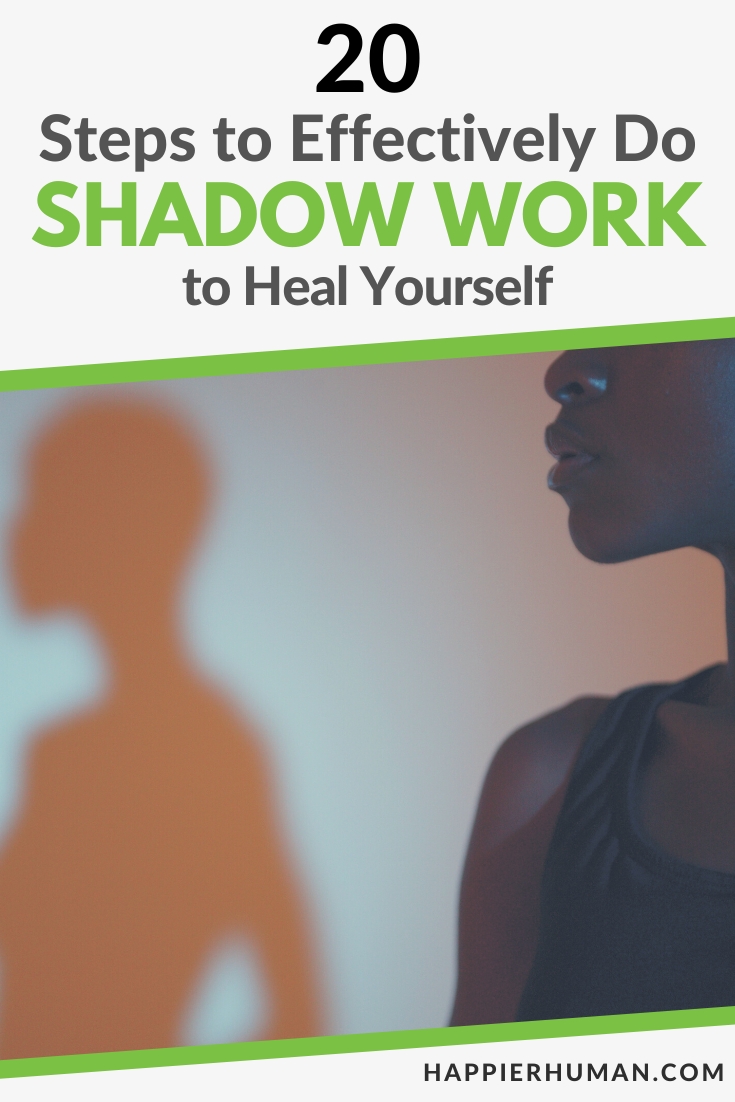There might be affiliate links on this page, which means we get a small commission of anything you buy. As an Amazon Associate we earn from qualifying purchases. Please do your own research before making any online purchase.
Everyone has deep, dark parts of their psyche, whether they admit it or not. It’s a small fragment of all that makes us human.
Many people shove these pesky, stigmatized shadows into the deepest corners of who they are, hoping no one else will notice them.
Other people learn how to do shadow work to engage, understand, and heal them.
From experience, I can assure you that anyone who talks about healing, lives in healing, and shares healing with others has practiced shadow work in their own lives.
It is the only way to heal your heart and mind.
This article will explain shadow work, why you may need it, how it works with inner healing, and demonstrate steps to do it. It will also gift you with resources and links to further your knowledge in doing shadow work.
What is Shadow Work?
Shadow work is a dedicated psychotherapeutic exercise that uses self-introspection and self-reflection to identify and target dark aspects of yourself to improve and heal.
Anyone can do shadow work to improve themselves. Some prefer to engage in it with guidance from a professional counselor or therapist. Others choose to do the work independently and in their own space.
Reasons You May Need Shadow Work
Those dark little aspects of yourself that blossomed from some rooted source affect how you conduct your life, the decisions you make, and how you relate to yourself and others on a daily basis. They have shaped your life from its origin, and you may not even realize it.
Shadows can cause harmful side effects that hold you back, make you ill, and create havoc. Ever wonder why your life hasn’t turned out the way you planned?
Check out these adverse side effects of not doing shadow work:
- Low self-esteem
- Anxiety
- Depression
- Panic attacks
- Anger
- Bitterness
- Unhappiness
- Offensive or belligerent behavior
- Self-sabotage
- Substance abuse
- Domestic abuse
- Unbridled ego
- Relationship difficulties or failures
- Loathing authority figures
- Playing the blame game
- Jealousy
- Self-deprecating behaviors
- Isolation
Undoubtedly, everyone can benefit from learning how to do shadow work. It connects and grounds you while healing and improving you as a whole person.
The only downsides to doing honest, focused shadow work that I have personally experienced are that it is uncomfortable and hurts initially.
Remember, it isn’t for pointing out bad qualities to eliminate them or give them acceptance to do bad behavior. It’s for exploration and healing.
Shadow Work and Healing
It is crucial to understand that emotional healing occurs in a step-by-step process.
It takes time and patience, so be cautious about having unrealistic expectations during this part of your journey. Each step must be approached with an open mind, focus, and in-depth evaluation.
The steps to emotional healing include:
- Becoming aware and recognizing the pain and trauma
- Acknowledging the pain and trauma and the fact that it caused a problem
- Accepting that the pain and trauma can be healed
- Feeling the pain as if it just happened
- Grieving the losses caused by the pain and trauma
- Forgiving yourself and others for the pain and trauma
- Committing to move forward, shaping your life how you want it to be
Shadow work targets repressed emotions, thoughts, memories, and feelings that have grown or stick around to create dark aspects of yourself later in life.
Shadow work is more of an understanding of what the dark aspect is and where it originated. It brings the issue to the forefront so you can identify and work on it.
20 Steps to Effectively Do Shadow Work to Heal Yourself
These steps to do shadow work to heal yourself may be blended, overlapped, or moved around according to each individual’s needs and goals. A professional counselor can help you get started.
Step 1: Decide if you will do shadow work on your own or want a counselor or therapist to assist you.
These are two ways to approach shadow work and healing. Both have pros and cons to consider.
On Your Own
Pros
Cons
With Professional Guidance
Pros
Cons
Step 2: Get to know your shadow.
Getting to know your shadow is getting a glimpse of it, recognizing it, calling it out, and acknowledging its existence. One of the best ways to do this is by focusing on perception.

Step out of yourself and observe issues in how others perceive you and how you perceive yourself.
Do you recognize any of these of these traits in yourself?
- Bullying
- Arrogance
- Aggressiveness
- Impatience
- Inattentiveness
- Inconsiderate
- Unkindness
- Combativeness
- Defensiveness
- Frustration
- Anger
- Vengefulness
- Self-deprecation
- Self-harming
Once you’ve recognized a trait, ask yourself why it exists. When was it born into your life? What kick started the feelings associated with it?
Remember, healing comes with allowing your present self to feel the initial pain that your shadow still feels. This is where it all begins.
Step 3: Reflect on your childhood.
Our formative years are critical in how we develop, view the world, and believe the world views us.
Reflecting on this time often guides us to the point of origin of where the problems began. Getting to the source is the whole point of doing shadow work.
Step 4: Accept your shadow, and don’t feel ashamed.
From childhood on, we bundle our undesirable dark aspects and hide them in a closet with the hope they will never be discovered. Because we’ve been trained only to appreciate and display our “good” traits, we feel shame that we even have any shadows.
Accepting your shadows doesn’t mean you approve or disapprove of them. It simply means you acknowledge that they exist. Don’t feel ashamed of having them. Everyone has them.
Step 5: Concentrate, meditate, and identify your emotional triggers.
Emotional triggers are anything that sets off a powerful negative emotional response. They are as varied as every individual’s experiences, so they really can be just about anything.
Emotional triggers can cause you to experience physiological effects like the following:
- Chest pain
- Rapid heart rate
- Rapid breathing
- Dizziness
- Nausea
- Tremors
- Anxiety
- Rage
- Fight-or-Flight response
- Panic attacks
- Incoherent speech
- Muscle weakness
- Blackouts
When doing shadow work, you focus, concentrate, meditate, identify, and validate your emotional triggers. As you practice and continue working with your shadows, you decrease the severity and frequency of the adverse side effects.
Step 6: Keep a written shadow journal and shadow prompts.
Keeping a journal and using prompts reaches into the darkness and pulls forth the shadows. It makes the “unconscious conscious,” so you can begin working on it.
Besides thoughts, feelings, ideas, and perceptions, also include your dreams. Dreams delve deep into your psyche and give glimpses of shadows you may not even know you had.
Take a look at the following shadow work prompts to help you get started:
- How do you picture yourself as a child?
- In childhood, what was your biggest fear?
- What memory do you have as a child that makes you feel shame?
- As a child, were you ever told how to react or feel?
- What would be your first impression of meeting your “shadow self” face-to-face?
- What are your negative personality traits?
- Do you avoid talking about your past in conversations?
- Does your feeling of self-worth come from a healthy place?
- Do you ever self-sabotage?
- Do you have negative self-talk?
- Do you like you?
- Do you like animals more than people?
- Do you have dark thoughts about others?
- Do you judge others?
- Which emotion makes you most uncomfortable?
- How do you deal with criticism?
- Do you ever feel misunderstood?
- Can you remember where you were the last time you felt real peace?
- What gives you anxiety?
- Do you have bad habits you use to escape pain or difficult situations?
Step 7: Allow your shadow to express itself through creative avenues.
The creative arts like painting, dancing, writing, acting, music, and other genres are like swirling energies within you. They tap into your shadows and express themselves outwardly.

There is something extraordinary about allowing your shadow to flow through art, manifesting itself as something tangible and valid. It is confirming, forthright, and accepted without judgment or ridicule.
Step 8: Communicate with your shadow.
Communication is key in any relationship. It is also true for your relationship with your shadow self and inner child.
- First, you must determine your tool to connect.
- Then, with compassion, confront source issues that gave the shadow life.
The three main ways to connect and communicate with your shadow include:
- Meditation
- Visualization or symbolization
- Hypnosis
Step 9: In my research, experts indicate that no emotions are bad; the good are stabilizing, and the bad point to areas to work on.
Experts indicate that throughout our lives, we’ve been taught to categorize emotions into good and bad. When you drop the categorization, you find that all emotions are beneficial. In turn, you grow emotionally and intellectually by leaps and bounds.
Experts note these examples:
- Fear connects you to your intuition and instincts to help them improve.
- Anxiety readies you for the future.
- Anger teaches you how to set boundaries.
- Shame can guide you to control your ethics and morals.
*Areas noted by experts that I disagree with allude to “no emotions are bad but are beneficial.”
First is the fact that negative emotions can overwhelm the brain with cortisol. Large amounts of this chemical released by the brain into the body are proven to cause illness, disease, and other major health problems.
Second is the fact that negative emotions often result in ugly behaviors that affect others directly, causing more emotional, physical, or traumatic harm.
Step 10: Be kind to your shadow self.
If you approach your shadow self with despise or the intent to wipe it out, you will contradict what shadow work is all about. Instead, engage with your shadow self with kindness, compassion, and a nonjudgmental attitude.
These are some reasons why:
- Acceptance, not rejection, is the key to success in shadow work.
- The objective of shadow work is exploration and understanding.
- Your shadow has already been through enough.
- Being kind to your shadow will increase your compassion for others, too.
Step 11: Nurture and heal your inner child.
Using meditation and visualization, you can connect directly with your inner child. There, you can give it hugs, unconditional love, and loving words of courage and strength.
Your inner child no longer has to hide, quiver in fear, or feel abandoned. Hand in hand, you can conquer anything.
Step 12: Identify, understand, and reward your worth.
Take a look at the following ways to do this:
- List all your contributions at home and at work.
- List your achievements.
- List your intentions and motivations.
- Always speak positively about yourself.
- Request what you deserve, even if you’re shaking in your shoes.
- Surround yourself with positive energies.
- Practice self-care often.
Step 13: Believe in yourself and your intentions.
These are a few ways to train to believe in yourself:
- View failures and mistakes as building blocks rather than dead ends.
- Eliminate limiting beliefs.
- Meditate on self-love.
- Create positive and mindful habits.
- Feed your brain healthy, positive, and enlightening stimuli.
- Challenge yourself to learn something new.
- Nurture your inner strength and your inner child.
Step 14: Question why your shadow feels the emotions it does. What is the origin?
Every shadow emotion arises from a source, whether an incident, a tragedy, or developmental teaching. Tapping the source is crucial to understanding your shadow self.

These are some of the shadow emotions to look for:
- Embarrassment or shame
- Disgust
- Anger
- Sadness
- Fear and anxiety
Now, ask your shadow where it began or why it feels like it does.
Step 15: Learn how to breathe.
You’d think this is a no-brainer, but few people understand how to breathe correctly. However, it is a critical part of learning how to do shadow work.
Taking oxygen into your body in a controlled, mindful manner provides many benefits like these:
- Eases the body in moments of tension
- Replenishes the brain and bloodstream with vital oxygen
- Decreases anxiety and depression
- Relaxes the central nervous system
- Lowers blood pressure
Click here to learn how to breathe better. This is something we all should learn to do.
Step 16: Choose your trusted friends and confidantes with great care and caution.
When you select friends, confidantes, or counselors to help you with your shadow work, trust is the most important thing. Self-discovery is serious. To alter or damage it with mistrust can cause irreparable harm to the seeker and the relationship.
Step 17: Identify and respect your shadow’s boundaries and triggers.
Identifying and respecting your shadow’s boundaries and triggers strengthens trust with your inner child and shadow self.
As with any relationship, the inner workings are built upon trust.
Step 18: Always remember that healing requires gratitude, compassion, and understanding.
From celebrating small victories to journaling and expressing thanks for waking up each day, gratitude empowers and promotes healing on a large scale.
Here’s why:
- Gratitude aligns your brain and neuropathways toward positivity and growth.
- Gratitude sets the tone for the entire day.
- The Law of Attraction means that gratitude will bring more miracles into your life to be grateful for.
- Gratitude lays a strong foundation for you to do shadow work.
Step 19: Make determined steps to direct your life’s path in the direction you want it to go.
Once you have started shadow work, you can immediately begin taking steps to live the life you really want. The steps are pretty straightforward.

Check this out:
- While doing shadow work, uncover your purpose in life—what makes you happy.
- Set milestones to get where you want to be.
- Study the daily habits of people who have already succeeded.
- Keep your eye on your goal and what you want.
- Stay motivated by celebrating milestones and breaking down barriers.
- Be flexible to refocus when things change.
- Shake off expectations and limitations, striving and driving toward your goals.
Step 20: Observe your shadow with compassion and objectivity.
This step goes beyond just being kind to your shadow. It pertains to how you perceive it within your overall self.
These are a few benefits of objectivity with your shadow:
- You’ll begin keeping calm around other toxic people and view their shadows with compassion.
- Your creativity and hidden talents will surface and bloom.
- Your whole-person wellness will improve.
- Your outlook on life will improve.
- Your positive energy will increase.
- You’ll develop better and stronger self-esteem and confidence.
- You’ll have better clarity about everything.
- Your relationships will improve.
- Your compassion and empathy toward others will increase.
Learning how to do shadow work effectively is the best thing you can do to improve your life and the lives of others. Realistically, it is something everyone should do. We all have shadows.
Final Thoughts on How to Do Shadow Work
Learning how to do shadow work and honing your skills are the only authentic ways to find healing. The cool thing is that it is readily available to everyone. You just have to take the first step to get started.
Shadow work provides an exciting adventure to discover what makes you tick and how to improve your life.
As you progress with your shadow work safari, you’ll find that you can reclaim your life, get it on the right track, and live the life you’ve always wanted. You have the power! Ready to begin? Check out 111 Deep Shadow Work Prompts for Beginners in 2024.
And if you're looking for more articles about self awareness and self discovery, be sure to check out these blog posts:
- 15 Steps to Practice Future Self Journaling
- 13 Self-Awareness Examples You See Throughout Life
- 15 Signs Someone Has a Lack of Self-Awareness


